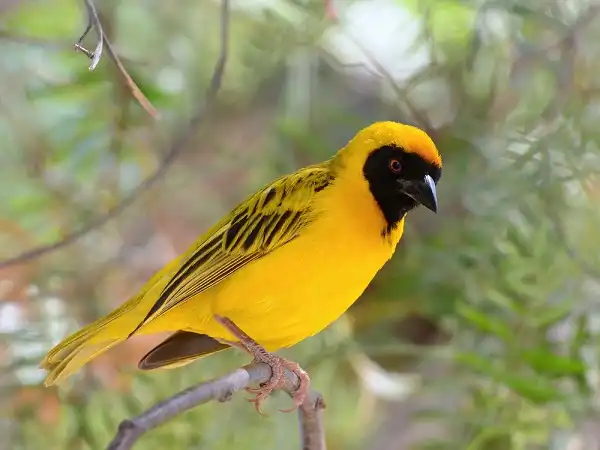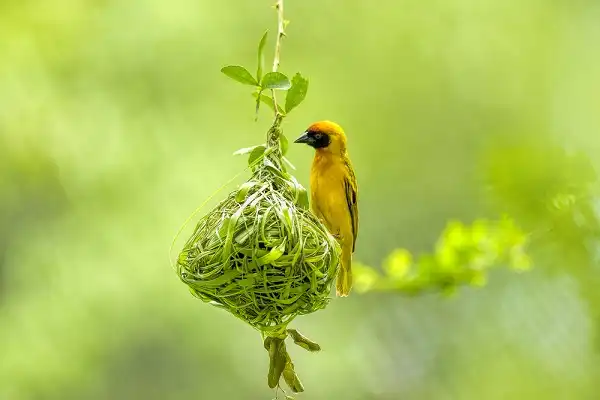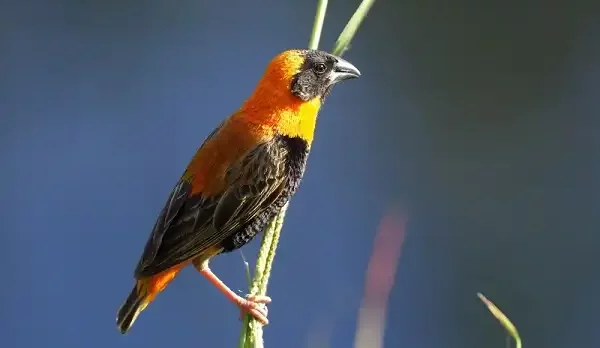Discovering the wonderous weaver bird can easily capture your curiosity. These remarkable birds are mostly found in sub-Saharan Africa, parts of South Asia, and Australia; with an estimated 19 distinct species and dozens of color variations. This blog post will provide insight into their unique behavior and the roles they play in helping to maintain a healthy environment. From how they build complex nests to the adaptability that has allowed them to survive for thousands of years, this is one creature you won’t want to miss learning more about!

Weaver Bird Description
Weaver birds are a small species of passerine bird, found in a variety of habitats across the world. The most distinctive feature of weaver birds is their colorful plumage, which comes in a variety of hues such as yellow, orange, brown, grey, and black. In some species, males may be more brightly colored than females. Weaver birds are known for their complex nesting behavior; they build intricate nests by weaving plant material into mats or bags suspended from branches or crevices. Some species may construct several nests within one season, while others will use the same nest for many years. The nests may contain multiple chambers with separate entrances for each chamber, providing protection from predators. Many weaver bird species use cooperative breeding strategies where several adults help raise the young together.
Weaver Bird Habitat
Weaver birds are found all over the world, mainly in sub-Saharan Africa and parts of South Asia and Australia. In addition to these regions, they can also be found in various other countries including India, Vietnam, China, Central America, and even some parts of the United States. Their preferred habitats vary depending on species but generally include grasslands, wetlands, woodlands, and shrublands. Weaver birds prefer open environments with plenty of tall grasses or shrubs for nesting material. They may build their nests in trees or on the ground, depending on the species and local conditions; multiple weaver bird species may occupy the same area at different times of the year. Some species may migrate to other areas during certain times of the year to find more suitable habitats for breeding. They often choose wetlands or other permanent water sources as locations for their nests, as these provide a reliable source of food and protection from predators. These birds can easily adapt and thrive when faced with changes in their environment; for instance, when a wetland is drained they will move to nearby woods or agricultural land to find food and nest sites. They are also capable of surviving in urban environments while still having access to green spaces such as parks or gardens where they can find food and nesting materials.
Weaver Bird Diet
Weaver birds have a mostly insectivorous diet, meaning they primarily consume insects. They feed on a variety of flying and crawling insects such as beetles, moths, grasshoppers, and caterpillars. Weaver birds may also eat other invertebrates, small lizards, and amphibians. Some species supplement their diet with seeds, fruits, and nectar from flowers. In addition to the insects they catch in flight, weaver birds also glean food from trees or shrubs by searching through the foliage for insects or eggs. They are also known to probe crevices in tree bark or search for food on the ground beneath vegetation. Weaver birds typically build their nests close to an abundant source of food that is easily accessible during the breeding season; this could be near water sources where there is plenty of insect larvae or close to flowering plants where they can feed on nectar and pollen as well as insects that are attracted to it.

Weaver Bird Size
Weaver birds are typically small to medium-sized birds with an average body length of between 10 and 25 cm (4–10 inches). They have a relatively short tail compared to other passerines, with most species having a tail ranging from 3-7 cm. Their wingspan also varies depending on species, but it is usually between 15 and 30 cm (6–12 inches). Weaver birds also vary considerably in weight; some of the larger species like the African Golden Weaver can weigh up to 40 grams (1.4 ounces), while smaller species such as the Grey-headed Social Weaver may only weigh around 12 grams (0.42 ounces). Some common genera of weavers include Quelea, Ploceus, and Emberiza which encompass both larid and passerine types of these birds.
Weaver Bird Lifespan
Weaver birds have an average lifespan of 8-10 years in the wild, though some individual species may live longer. In captivity, they can live up to 15 years or more. The longevity of weaver birds largely depends on their diet and habitat conditions; birds that are able to access a reliable source of food and water will typically outlive those living in more hostile environments where resources are scarce. In general, weaver birds begin breeding when they reach 1 year old, but depending on the species this can range from 3 months to 4 years. During this time, they tend to establish lifelong pair bonds with their mate and remain monogamous throughout their life cycle as long as both individuals survive. The average clutch size for most weaver bird species ranges between 2-6 eggs per nest and incubation usually takes around two weeks depending on the temperature. After hatching the chicks will stay in the nest for about another three weeks before fledging and becoming independent from their parents.
Weaver Bird Behavior
Weaver birds are highly social creatures, with some species forming large colonies of up to several thousand individuals. They have complex communication and courtship behaviors, which involve a variety of vocalizations and physical displays. During courtship rituals, male weavers may perform elaborate dances to attract potential mates, often accompanied by song. Weaver birds are also highly skilled at weaving nests; they weave grasses into intricate structures that are both practical and aesthetically pleasing. These nests help to protect the bird’s eggs and chicks from predators as well as provide shelter from extreme weather conditions. In addition to building nests, weaver birds also form large flocks when foraging for food or migrating between different habitats. Some species will even flock together year-round in order to better defend their territories from competitors or predators. Weaver birds often establish hierarchies within their flocks; usually the oldest and most experienced individual will take the lead role, while younger birds are expected to follow its instructions and observe proper protocol when interacting with other members of the flock. This helps to ensure that all members act in accordance with one another and maintain harmony within the group.

Weaver Bird Speed
Weaver birds are generally light and agile, allowing them to reach impressive speeds in short bursts. During the flight, they can reach up to 20 miles per hour and can sustain 8-10 mph for long distances. They are also capable of sharp turns and quick takeoffs, allowing them to easily maneuver through dense vegetation or avoid potential predators. Weaver birds have also been known to fly up to 2 miles in one direction while searching for food or shelter. This migratory behavior is more common during the breeding season when flocks of birds may travel from as far away as Africa or Asia in search of suitable nesting sites. Although weavers tend to fly at a relatively slow pace, their agility and dexterity allow them to quickly change direction and speed when necessary. This helps them traverse densely wooded areas more efficiently than larger birds such as hawks and eagles. When faced with danger, weavers can even drop down from the sky at incredible speeds in order to evade predation.
Weaver Bird Hunting
Weaver birds are skilled hunters, utilizing their speed and agility to quickly identify and chase down potential prey. They primarily hunt small insects such as beetles, spiders, grasshoppers, and caterpillars but have also been known to capture larger prey such as lizards or fish. When hunting, weavers typically fly low to the ground while searching for food sources. They will often swoop down from above and snatch up unsuspecting prey before returning to a safe perch. Weavers also use a technique called hovering where they will hover in one spot for extended periods of time in order to more accurately target prey. To make sure that their energy is spent efficiently when hunting, weavers will often use various strategies such as forming small groups or using coordinated movements with other members of the flock. This helps them to both increase the chances of locating a meal and reduce the amount of work that each individual has to do on their own. Weavers have also been known to utilize tools in order to assist them during hunting expeditions. For example, some species of weaver birds have been observed using sticks or pieces of vegetation as probes when searching for food sources in harder-to-reach areas. Additionally, some individuals have even been seen constructing crude fishing lines out of grasses and other materials in order to capture smaller fish!

Conclusion
Weaver birds are incredibly fascinating and intelligent creatures that have captivated us for centuries. With an impressive range of capabilities, they possess incredible speed, agility, and dexterity which allow them to effectively navigate their environment while searching for food or shelter. They are also skilled hunters who utilize various strategies such as forming groups or using tools in order to maximize the efficiency of their energy when hunting. Overall, weaver birds make for amazing creatures to observe in nature and will continue to astound us for years to come!
Frequently Asked Question

